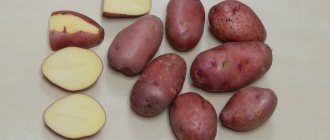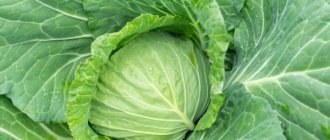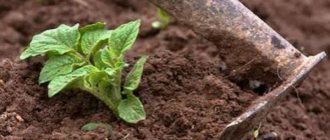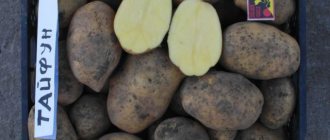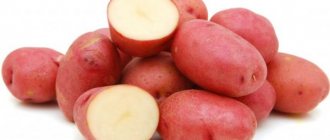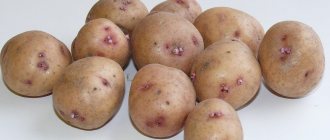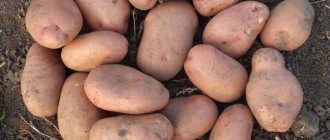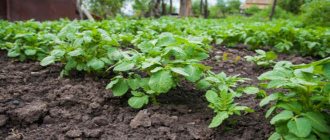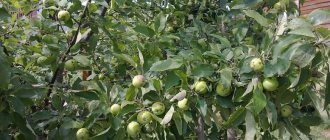Description of the variety, photos and reviews of the Sonnok potato convince us of its excellent commercial and nutritional qualities. Among crops grown for winter storage, it stands out for its ease of care and unpretentiousness to weather conditions. The Sonny potato is deservedly considered a national potato, because its breeding cannot be attributed to one breeder. The amateur variety is not included in the State Register and has not passed official tests, which did not prevent it from becoming one of the most popular in Russia.
Characteristics of the potato variety Sonny
The mid-late table potato variety Synok is also known to summer residents and farmers under the name Bogatyr. The culture combines most of the qualities necessary for the “folk” potato: the ability to bear fruit well with a minimum of care, excellent taste, versatility and excellent keeping quality.
Potato bushes grow low, about 0.5 m. The stems are strong and erect. The more fertile the soil, the denser and more spreading the bushes. The leaves have a typical potato shape, medium size, bright, with a wavy edge. The green mass of a healthy bush creates dense shade.
Flowering of the Sonnok potato begins with the appearance of large white buds, collected at the tops of the shoots into compact corollas. Blooming flowers fall off after 2 days. Few green fruits with seeds are produced.
Main characteristics of potatoes of the Synok variety:
- medium-sized fruits, average tuber weight – 80 g;
- the shape is round, slightly flattened, the size of the potatoes is equalized in one bush;
- the eyes are shallow, inconspicuous, concentrated at the apex;
- the peel is thin, creamy, with an inconspicuous mesh;
- The pulp is white, medium starchy.
The root system is well developed, but does not branch far beyond the circumference of the crown. Directly under the bush, from 10 to 30 small potatoes are formed. The number of tubers directly depends on the fertility of the soil and the use of agricultural techniques: hilling, loosening, watering.
Characteristics
Sonny (Bogatyr) belongs to the mid-late potato varieties. Ripening times depend on the region and weather conditions, but on average 120-130 days pass from germination to harvest.
Productivity
The variety is high-yielding: 9-11 kg are harvested from one bush. The tubers are medium and large in size, each weighing 75-80 g, individual specimens reach 150-200 g.
Disease resistance
Sonny (Bogatyr) is resistant to scab, cancer, blackleg and golden nematode. In rare cases, it is susceptible to late blight.
Description of tubers and appearance
The tubers of the variety have an attractive appearance:
- smooth;
- with small eyes in a small number;
- the peel is thin, cream-colored with a pinkish tint, resistant to damage;
- round-flat shape;
- The pulp is white and does not darken when cut.
Regions for cultivation and climate requirements
The variety is grown in different regions, as it easily tolerates temperature changes, lack and excess of moisture, heat and temporary cold snaps. Grows in the regions of the Central Black Earth Region, the Urals, Siberia, and the Far East.
Taste qualities
From the emergence of seedlings to the start of harvesting, an average of 130 days pass. During this time, the tubers manage to accumulate many useful substances: vitamins, amino acids, fiber, proteins. The variety has a pronounced potato taste with an average starch content (about 14%). Which, when combined, produces aromatic pulp that is crumbly when cooked and retains its shape when frying or baking.
The variety is suitable for making French fries. Peeled tubers do not darken in air, maintaining an even white color when cut and frozen. When cooked in oil, the slices form a crispy crust.
Potatoes of the Sonnok variety in reviews always deserve only close to excellent ratings for taste. The high quality of tubers is maintained during long-term storage.
Correct fit
Potato Sonny is an unpretentious variety. However, to obtain a high-quality harvest, a number of rules must be followed. And you need to start doing them long before the start of planting work.
There is no need to plant the crop in the shade. It is also advisable that the site be surrounded by a small fence that does not block the sun, but protects from gusts of northern winds.
Planting material is selected in the fall, immediately after harvest. Then, during sorting, the best tubers are selected. They must be free of any visible defects (growths, cracks, stains, insect tunnels, rot, etc.). Also, it is advisable to choose potatoes weighing 70 g.
In spring, prepared planting material is pre-germinated. To do this, the root vegetables are taken out of the cellar into a bright and warm room with a temperature (16-18 C). Many gardeners use special growth stimulants to make tubers germinate faster. Also, planting material is often treated with fungicides to protect the crop from fungal diseases and pests.
The site is being prepared in the fall. The soil is dug up (plowed over). All weed roots are completely removed from the site. At the same time, fertilizer (most often humus) is applied. You can also use wood ash.
In spring the soil is loosened. Planting is carried out only when the soil warms up to +8-10 degrees Celsius. Usually this period occurs when the buds on the birch tree begin to open. Therefore, if there is a birch tree nearby, you can navigate by it.
Standard landing pattern:
- 30-35 cm between holes;
- 60-70 cm between rows.
This row spacing will allow the bushes to receive a sufficient amount of sunlight without shading each other. Also, good aeration is ensured.
The root planting depth is 8-10 cm in light soil and 5-6 cm in heavy soil.
Pros and cons of the Sonny variety
The crop is cultivated throughout Russia and in adjacent countries. Greater yield losses are noted only in regions with the shortest, wettest summers. The popularity of potatoes is due to many exceptional qualities:
- resistance to high and low temperatures, significant daily fluctuations, drought;
- ease of storage and versatility in use;
- the possibility of long-term cultivation without replacing seed;
- resistance to major potato diseases;
- tolerance for lack of care.
The main criterion when choosing the Synok variety for planting for the winter is its ability for long-term storage.
The only drawback noted with the Synok variety is the lack of official certification, which is why there are discrepancies in the characteristics and descriptions of the potatoes. Continued use and independent selection of material by gardeners can modify some crop parameters.
Origin and development of the variety
The variety is old; it has been grown in Russia, Belarus, and Ukraine since the last century. It is not in the state register of the Russian Federation, but it was developed in our country at one of the Far Eastern experimental stations.
The author is considered to be the Federal Scientific Center for Agrobiotechnologies of the Far East named after. A.K. Seagulls."
Planting and caring for potatoes Sonny
The yield of a variety and the timing of its harvesting strongly depend on the time of planting. Most often, work is carried out in April or early May, focusing on soil temperature. As soon as the soil warms up to + 8 °C, the Sonny potatoes can be prepared for planting. There is no point in delaying work until warmer weather - the sooner the potatoes are planted, the better yield they can show.
Selection and preparation of a landing site
The variety is unpretentious to the composition of the soil. The only criterion that is critical for any potato is the acidity of the soil.
Advice! At elevated rates, you will need to add dolomite flour, chalk or slaked lime to the soil. The addition of crushed eggshells fertilizes and deoxidizes the soil well.
Rules for selecting and processing a site for the Synok variety:
- They try to select an area where potatoes or tomatoes have not previously grown. Good predecessors are melons, legumes, alfalfa, rye, and meadow grasses.
- The Synok variety shows the best yield in open, sunny areas. The soil must be dug up in the fall to a depth of 30 cm, removing weeds.
- During digging, mineral and organic fertilizers are applied simultaneously. For 1 sq. m measure 10 kg of humus or rotted manure, 25 g of superphosphate, 10 g of potassium sulfate.
- Chemical fertilizing can be replaced by adding wood ash in the amount of 0.5 kg per 1 square meter. m. Application of fresh manure or peat to potato beds is contraindicated.
Spring soil preparation involves deep loosening, leveling the area and marking rows.
Preparation of planting material
The Sonny variety does not degenerate with prolonged use of its own material. Tubers intended for spring planting are selected during harvesting for separate preparation and storage.
For 10 sq. m of area on average will require about 4-5 kg of seed material. Healthy, regularly shaped potatoes are selected for planting next year. The size of the tubers is not critical; the main thing is to take material from the strongest and most developed bushes with the largest yield.
Attention! According to reviews from experienced gardeners, planting the Synok variety in parts of tubers gives the same results as whole potatoes. If it is necessary to use large specimens as seeds, it is permissible to cut them.
For rapid propagation from several potatoes, planting with germinated eyes is used.
Pre-planting preparation of seed potatoes:
- Immediately after harvesting, potatoes sorted for seeds should be kept in the light until the skin turns green (from 3 to 5 days). Such tubers are stored better and are not prone to premature germination.
- 30-40 days before planting, Sonnok potatoes are heated in a room with a temperature of about + 16 °C.
- For germination, access to light and air is provided: potatoes are scattered in a layer of 2 tubers on the floor or placed in mesh bags.
Potatoes are sprayed with a spray bottle several times a week. At night, it is advisable to lower the temperature.
Important! Potatoes with strong sprouts up to 1 cm in length are considered high-quality planting material.
Landing rules
The description of the potato variety Synok recommends planting the crop according to a 35x70 cm pattern. In practice, an increase in yield has been noted when the rows are thickened. When planted densely, the interlocking potato tops cover the row-spacings with thick shade, which reduces moisture loss, reduces the growth of weeds, and saves space in the garden. The Sonny variety only benefits from this method of cultivation.
Potatoes are planted in holes or in rows, observing the following rules:
- make furrows along the entire length of the area, sprinkle them with ash;
- placement depth on light soils is up to 10 cm, on clay soils – up to 6 cm;
- potatoes are laid out in recesses and sprinkled with loose soil;
- The Sonny variety does not need to be watered when planting.
Advice! If the soil has not warmed up enough by May, you can put humus or last year’s leaves under each potato.
Rotted organic residues release heat and warm the tubers. It is useful to cover the beds with non-woven material or dark film until sprouts appear.
Watering and fertilizing
In the middle zone, natural precipitation is sufficient for normal crop formation. During drought, abundant single watering is recommended. For the Sonny variety, the best time for additional moisture is the flowering period, when tubers are laid. In hotter climates, watering is carried out no more than once every 15 days.
If the beds are prepared in advance with the application of fertilizers in the fall, then there is no need to fertilize the potatoes during the season.
Loosening and weeding
One of the advantages of the variety is its undemandingness to weeding and loosening. If possible, keep the soil clean until the tops close. After this, weeds appear rarely, and the soil dries out less.
It is important to remove the crust that forms on the surface before germination. Later, the beds cannot be loosened, because most of the tubers lie close to the surface.
Hilling
One of the techniques that increases potato yields is adding soil high to the base of the bush. Such hilling is contraindicated for the Synok variety due to overheating of the tops and the risk of damage to the surface roots on which the tubers are planted.
Some gardeners claim that by adding a little soil to the bushes, you can increase the yield. Low hilling does not harm the variety, but the Sonnok potato produces an excellent harvest without additional care.
Row spacing in beds with Sonok potatoes can be mulched with cut grass, protecting the soil from drying out and protecting the roots from overheating.
Advantages and disadvantages of the variety
The Sonny potato quickly gained popularity among Russian gardeners due to its undeniable advantages:
- General unpretentiousness when growing. In Russia, Sonny produces good harvests both in warm regions and in areas with a temperate climate. It is little susceptible to the vagaries of the weather and sudden changes in temperature. It tolerates prolonged heat or cold summers, lack of sun, and does not suffer from droughts or prolonged rains.
- Resistance to crop-threatening diseases and common pests. My son is not affected by potato cancer viruses, scab, nematode, or “wet” rot. It has good resistance to late blight of tops and tubers.
- High yield. The tubers themselves are relatively small, but there are a lot of them. On average, 4–5 kg of potatoes are harvested from one bush, and with proper agricultural technology and cultivation in fertile soil, even 8–10 kg is quite realistic.
- Possibility of long-term storage. This is a distinctive feature of all late varieties, but here Sonny stands out especially. Even tubers that have received mechanical damage during the harvesting process can be stored. Potatoes do not spoil if the conditions in the cellar or basement differ from optimal ones. They are able to withstand changes in temperature and humidity.
- Attractive appearance of tubers and their taste. The first makes the variety promising for cultivation not only for personal consumption, but also on an industrial scale. Everyone who has tried dishes from it agrees that Sonny has a very rich taste. Due to the relatively low starch content, the snow-white pulp does not darken during heat treatment, and the tubers and individual pieces retain their shape. Sonny is suitable for preparing any culinary dishes - soups, side dishes, salads and so on.
- Saving planting material when propagating vegetatively. It needs updating due to loss of quality approximately every 6-7 years. For planting, you can use parts of them rather than whole tubers.
- Disembarkation scheme. Gardeners who have been cultivating Sonnok for several years have noted an increase in productivity with thickened planting. This (coupled with the compactness of the bushes) allows you to save space in the garden, which is always in short supply.
- Compactness of the “nest” with tubers. Potatoes are located in a circle with a diameter of 25–30 cm, the center of which is the bush, and at a depth of 10–30 cm. This minimizes mechanical damage during harvesting.
Among the main advantages of the Synok potato variety are excellent taste and versatility of purpose.
It also has some disadvantages:
- A small number of fruits. But this does not matter for all gardeners, but only for those who use seeds to grow Sonny mini-tubers at home, thus updating the planting material.
- An unclear question regarding the transgenicity of the variety. As a rule, any new variety, and not just potatoes, is accused of being genetically modified. There are no reliable facts confirming or refuting this statement regarding Sonny yet. Perhaps this will be officially clarified in the State Register if the variety is included there.
Diseases and pests
The Synok variety is highly resistant to the following nightshade diseases:
- golden nematode;
- potato cancer;
- common scab;
- all types of bacterial wilt;
- blackleg;
- Alternaria blight.
Due to the long ripening period, Sonnok potatoes can be affected by late blight. Treatment with copper-containing compounds helps prevent the disease. All green parts of the plant affected by late blight must be removed from the site and burned.
Healthy, strong potato bushes Sonnok are rarely damaged by insects. The threat increases if hot weather persists for a long time or rains do not stop. Plant immunity weakens, typical potato pests may appear:
- potato moth;
- Colorado beetle;
- wireworm;
- mole cricket;
- aphid.
Treatment to get rid of each type of pest is carried out with specific insecticides. Insects are repelled by adding mineral fertilizers to the soil and pollination with ash.
Attention! Organic fertilizers, on the contrary, can attract soil pests.
How to harvest and store crops
The Sonny variety should be planted early and harvested as late as possible. In order not to provoke late blight disease, the tops should be removed half a month before harvesting. You can harvest potatoes after the bushes have turned yellow and drooped.
To store potatoes for food after harvesting, they should be dried in the shade, but for seed tubers it is better to use the sun.
Proper storage of potatoes
Note! Potatoes are not harvested after rain; choose the driest day possible; it is advisable that the soil is completely warmed up.
Potatoes should be stored in wooden boxes in a dry, dark, well-ventilated place. First you need to remove all rotten and damaged tubers.
The variety takes a long time to ripen, but it can be preserved until spring. Its keeping quality is high. They should be harvested immediately after drying and periodically monitor the appearance of rot or spoilage in the crop. Such potatoes should be removed immediately.
Potato yield Sonny
Potatoes of the Synok variety are located in a diameter of 30 cm from the center of the bush with a depth of 2 to 20 cm. The compactness and shallowness of the tubers allows for machine and manual harvesting with minimal damage to the crop.
The photo of the Sonnok potato clearly shows the relative uniformity of fruit size in one bush. With high soil fertility and favorable weather conditions, each plant produces about 40 medium potatoes. The yield from one bush reaches 10 kg. Small and irregularly shaped tubers are quite rare.
With incomplete care and moderate soil fertility, the average yield rarely falls below 5 kg per bush. A decrease in fertility often affects the number of tubers, but not to the detriment of the size of the potatoes. The Sonny variety is rightfully considered economically profitable and always justifies the investment.
Harvest and storage
The harvest is harvested 120-140 days after germination. Ripening time varies depending on weather conditions. If the tops have turned yellow and fallen, the potatoes are ready for harvesting.
After digging, the tubers are dried in fresh air for 3-5 hours. Then they are put into storage (basement, cellar), where a constant cool air temperature and humidity are maintained.
How and when to collect
For cleaning, choose a dry and sunny day. The Sonny variety is harvested manually using a shovel or pitchfork. Mechanized harvesting is undesirable, since 25-40 tubers are formed in each bush, and they are located both in the center and on the sides of the bush.
Storage features and keeping quality of the variety
The optimal storage temperature for the variety is considered to be +2…+4°C. The permissible humidity level is 87-91%. Only under such conditions do tubers retain their properties and vitamins until the next harvest.
Storage
Before storing the potato harvest, it is left in the open air until completely dry. After 2-3 hours, the adhering soil is shaken off the tubers and placed in boxes or bags.
Store Sonnok potatoes in cool, dark rooms with good ventilation: cellars, cellars, pantries. The optimal temperature for tubers is + 4 °C. It is not necessary to sort the potatoes cut when digging. Even if storage parameters cannot be fully maintained, 95% of the harvest can last until spring.
Seed potatoes of the Synok variety, selected during harvesting, are stored in the same way as tubers intended for food. Greened specimens fit well in bags and do not require special conditions.
Potatoes from seeds
Most gardeners grow potatoes vegetatively, periodically simply purchasing new tubers for planting when the old ones gradually degenerate. If this is not done, the yield and quality of potatoes, as well as disease resistance, drop significantly.
But there is an alternative method that will not require large expenses from the gardener, because in specialized stores super-elite and elite tubers are quite expensive. And buying at all kinds of fairs or from hand is a big risk. Few people will be able to distinguish high-quality planting material from ordinary small potatoes and determine exactly what variety it is.
Growing potatoes from seeds is quite difficult and troublesome. Besides, Sonny doesn’t have too many fruits. Potato seeds cannot boast of germination, so you need to stock up on planting material in excess. But all difficulties can be overcome.
In addition, this is a unique opportunity to feel like a real breeder and develop a variety that no one else has. The fact is that mini-tubers grown from seeds vary greatly in shape, size, and skin color - this is a characteristic feature of potatoes. From these, you need to select those that best meet the criteria you have previously defined for yourself. Such potatoes are much better adapted than usual to the climatic and weather conditions of the growing region.
In the first year of growing potatoes from seeds, you will get approximately this yield
The procedure also has other undoubted advantages:
- Collected seeds, compared to tubers intended for planting, take up much less space and do not require special storage conditions. They can sprout in 6–10 years. But it is still not recommended to delay disembarkation for so long. The germination rate of potato seeds is not very good even without this.
- The absence of viral and bacterial diseases in mini-tubers, even if they affected the bush from which the seeds were collected.
- Higher yield. Practice shows that tubers grown from seeds yield an average of 10–25% more potatoes. The specific value depends on many factors - growing region, summer weather, soil quality, care, and so on.
Potato seeds are easy to collect yourself
There are also some disadvantages. Basically, this is the great capriciousness and extreme fragility of potato seedlings. Even with a slight deficiency of sunlight, it stretches greatly. Also, seedlings very often suffer from “black leg”, which can destroy the future harvest already at this stage. The root system forms very slowly; thin roots and stems are easily damaged during the picking process. Seedlings are quite difficult to transport. By the time it needs to be planted in the ground, it reaches a height of 15–18 cm, but does not have a strong stem, like, for example, peppers and tomatoes. Therefore, during transportation, the shoots often get tangled so much that it is almost impossible to unravel them.
It is much more difficult to grow potato seedlings than plants from the same family - tomatoes, eggplants, peppers
It is also worth knowing in advance that it is impossible to obtain large tubers from seeds in the first year. The first harvest will be harvested only next summer, after self-grown mini-tubers are planted in the ground.
Seeds for planting are prepared in the fall, collecting berries from the strongest and healthiest bushes, which are very similar to small green tomatoes. They should be elastic to the touch, not deformed, with clean skin. The collected “harvest” is left in the sun for 7–10 days. During this time, the fruits will wither, the skin will become wrinkled and turn white. They are cut in half with a sharp, clean knife, the seeds are separated from the pulp, washed and dried well. During the winter, they are stored in a cool, dark place, poured into plastic or glass containers or paper bags.
Fruits are best taken from the most developed and healthy potato bushes
Plant seeds in late winter or early spring. First you need to prepare the soil. It should be light, well-permeable to water and air, but at the same time nutritious. You can mix fertile turf and peat chips in a 1:4 ratio or add Nitrophoska (2–3 g/l) and coarse sand or sawdust (3:1) to the universal substrate for growing seedlings. The soil must be disinfected - treated with heat, steam, frozen, spilled with a solution of Glyocladin, Fitosporin or potassium permanganate.
The substrate for growing potato seedlings should be nutritious, but at the same time light and loose
The procedure itself looks like this:
- 5–7 days before the intended planting, the seeds are wrapped in gauze, which is constantly kept moist, regularly moistened with water or a solution of any biostimulant - Epin, Kornevin, Heteroauxin. Sometimes it is recommended to pre-harden them for 3-4 days, placing them in the refrigerator at night and leaving them in the sun or near a radiator during the day. The gauze is kept in a hermetically sealed plastic container, which is opened for ventilation for 5–10 minutes a day. After about a week, the seeds should germinate.
- Shallow wide containers are filled with prepared soil. It needs to be leveled and well moistened with a spray bottle. The seeds are laid out, leaving 3–5 cm between them, and 5–7 cm between the rows. Then they need to be sprinkled with a thin layer of fine sand and compacted very carefully.
- The container is turned into a greenhouse, covered with glass or plastic film. It is ventilated daily to avoid condensation. Ideal conditions for seeds are daylight of at least 10 hours (in most regions of Russia additional lighting will be required), bottom heating, temperature 25–27ºС. As the substrate dries, spray it with water or a weak (2–3 ml/l) solution of the same biostimulant. The first shoots should appear in 10–12 days, mass shoots – 3–4 days later.
- Water the seedlings very sparingly. In waterlogged dense soil, the roots immediately “suffocate.” After two weeks, the plants can be sprayed with a solution of any nitrogen-containing fertilizer (1–2 g/l) to stimulate the growth of green mass.
- When the seedlings have two true leaves (20–25 days after emergence), they are planted in small peat pots. Be very careful when diving, the seedlings are extremely easy to damage.
- About a month before the intended planting in the ground, the seedlings begin to harden, first taking them to a closed loggia, then to the open air. Gradually, the time spent outside is increased.
- Bushes ready for planting in the garden have a height of 15–18 cm and 5–6 true leaves. The soil for them is prepared in the same way as for ordinary potatoes; the planting scheme recommended for the variety is followed. You can only reduce the distance between rows by 5–10 cm.
- As a rule, they choose a cloudy day for planting or wait until the evening. 30–40 minutes before this, the prepared holes are spilled with water (0.5–1 l), a handful of humus and a little sifted wood ash are poured into each hole. The seedling is placed on the ground along with the pot (if it is peat) and sprinkled with soil so that only the real leaves are visible.
- To minimize stress for plants, arcs are installed above the bed, onto which any covering material that allows air to pass through is stretched. You can remove it at the beginning of summer, when the plants are strong enough and the weather is warm outside.
- Caring for seedlings during the summer is no different from caring for regular potatoes. Particular attention should be paid to weeding and loosening the beds. The harvest is dug up only when the tops completely turn yellow and dry. You should not discard very small tubers, the size of a fingernail or even a pea. Next year they can produce quite a decent harvest.
- The collected planting material is washed, thoroughly dried and stored in glass jars or plastic containers during the winter. They do not need low temperature and humidity, like regular potatoes.
Photo gallery: growing potato seedlings
Before planting in the ground, potato seeds must be allowed to germinate.
The first shoots from planted potato seeds appear quite quickly. Sometimes it is recommended to plant potatoes in sawdust, but this “substrate” is very difficult to constantly keep moist so that the seeds do not rot
Potato seedlings are buried in the ground until the first true leaves
Caring for potato seedlings during the summer is not much different from standard agricultural technology for this crop.
In principle, potatoes from seeds can also be grown without seedlings, sowing them directly into the ground, but in Russia this method is only suitable for southern regions with a subtropical climate, where the soil warms up to 10–12ºС at a depth of 8–10 cm already in April.
Video: growing seedlings from potato seeds
Reviews of potatoes Sonny
Marina Georgieva, 45 years old, Voronezh region.
I planted the Sonny variety for the first time this year. The impressions are only good. The shoots were early, powerful and very friendly. The tops quickly grew and thickly covered the beds, remaining green until they were dug up. I managed to water the potatoes once, but very generously, when there was no rain for a month. The results were surprising: one planted bucket yielded almost 100 kg of crop. I liked the taste: you can either boil it or fry it. It fits well and does not rot.
Vladimir Nagaev, 52 years old, Astrakhan.
The Sonny variety is not the only potato in my dacha. I always grow several varieties with different harvest times. Of the winter varieties, Sonny is the easiest to grow and reaches summer almost without loss. The potatoes are not large, but the harvest is always stable. The most convenient variety for those who do not have time to walk around the garden every day and hill up, loosen, and remove weeds. I think, given time, the harvests would be larger, but I’m happy with it anyway: 20 to 30 medium potatoes per bush is already a good result.
Advice from experienced gardeners and reviews about the variety Synok (Bogatyr)
Gardeners from different regions of Russia leave only positive reviews about the variety, noting its unpretentiousness, productivity and keeping quality.
Tatyana, an experienced gardener, Moscow region : “The son is resistant to drought, cold weather, weeds, and diseases. This variety does not require watering! Potatoes Sonny can be grown with eyes. Simply cut the tuber into small pieces, roll in ash and plant the next day. Tip: for convenience, use a marker to draw lines on the potato along which you will cut.”
Semyon, Astrakhan: “Very pleased with the potatoes Sonny: fully corresponds to the declared characteristics, the harvest is excellent and guaranteed. It does not require special care. If you feed the soil a little and adjust the watering, the result will exceed all expectations. I advise you to grow with eyes or cut parts, this greatly saves planting material.”
Tatyana, Voronezh : “Potatoes have excellent taste. The main advantage of potatoes is their low requirements for watering, hilling and weeding. If the tubers are dried, they last well until spring. I recommend Sonny to everyone! Minimum labor costs, and the harvest is impressive - the potatoes are simply heroic!”
Pests and diseases
Judging by the reviews, the Sonnok potato has good immunity to diseases and pests:
- bacterial wilt;
- common scab;
- Alternaria blight;
- blackleg;
- cancer;
- potato nematode.
This variety often suffers from late blight due to late ripening. Therefore, the tops are periodically treated with fungicides:
- "Fitosporin";
- "Prestige";
- "Quadris";
- "Hom" and others.
If a bush is affected by a fungal infection, it is better to dig it up immediately and destroy it, since the plant cannot be cured. If you do nothing, late blight will spread to neighboring bushes. To avoid this, it is recommended not to plant tubers in areas where tomatoes or potatoes of any kind have grown for several years in a row.
You should also periodically dust the bushes with wood ash, pour a weak tar solution into the rows, or add fresh sawdust. This helps repel insects. In extreme cases, it is necessary to use insecticides:
- "Fitoverm";
- "Biotlin";
- "Colorado";
- "Agravertine";
- "Decis".
Advice! Planting coriander, aromatic tobacco, marigolds, and calendula will help prevent pest invasion. Flowerbeds should be placed as close to the potato field as possible.
What can it hurt?
The description of the variety gives an idea of possible diseases of the crop. Resistance to late blight is average, so at the end of June it is recommended to carry out preventive spraying with honey-containing preparations that block the development of the disease. After heavy rainfall, it is recommended to pick the lower leaves and shoots.
The plant is often attacked by aphids, Colorado potato beetles, and wireworms. Destroy pests using insecticides. To prevent diseases and pest attacks, all seed material must be disinfected.
Potatoes Sonny (Bogatyr), set of 10 tubers
- Description
- Characteristics
- Reviews (2)
Amateur-selected potato variety Sonny.
The variety is mid-late, productive. Productivity is from 4 to 7 kilograms of potatoes per bush (from 15 to 40 potatoes). The tubers are oblong, rough, and have an excellent taste. The weight of the tubers is from 70 to 600 grams. Potatoes are located within a radius of 50-70 cm from the center of the bush, at a depth of 3 to 30 cm. High shelf life during storage. ATTENTION! Shipping and pick-up of seed potatoes will begin approximately in the fall of 2021; there are no more potatoes left for spring 2021. We are accepting orders (no prepayment required)
The price is for a set of 10 tubers. You can place your order now to reserve your potatoes. Hurry up to book, because there are not very many tubers expected.
We offer you a variety of amazing amateur-selected potatoes, Sonny. The son is resistant to: drought, cold weather, weeds, diseases such as late blight, gray rot and scab. The variety does not require watering. HOILING IS CONTRAINDICATED. Potatoes Sonny are planted exclusively with eyes. You will need to cut the tuber into small pieces, each with a sprout. Next, after cutting, roll each part of the tuber in ash (if there is no ash, in cement). It is better to plant the eyes the next day after cutting.
Early boarding is recommended. If planted later, the tubers will grow a little smaller, but the harvest will always be good. Potatoes are planted in a square nesting method 50*50 cm. Planting depth is 15-20 cm. They put a peephole in the hole and covered it with earth. After planting the potatoes, there will be a flat bed and no need to hill it up. Potatoes grow in a voluminous, green and tall bush and almost no weeds grow under them. Only the first time, when the potatoes begin to grow, will it be necessary to trim weeds along the surface or loosen the soil. As soon as the bush gains mass, there will be no weeds. Digging up the crop should be done no earlier than mid-late September. The variety is mid-late, productive. From 1 plant you get from 4 to 7 kg. potatoes. There are from 15 to 42 potatoes under a bush. When fully ripened, there is no small tuber. The tuber itself is oblong, smooth, with yellow flesh, and tasty. The weight of each tuber is from 70 to 350 grams. The tubers are located within a radius of 50-70 cm from the center of the bush, with a depth of 3 to 30 cm. The shelf life of this potato, even with mechanical damage, is high. It does not rot or deteriorate. The Colorado potato beetle doesn’t like it; if you plant another potato next to it, it will be the last one to infest on Sonny. And most importantly, the Sonnok potato variety does not degenerate over time; you will always have a stable harvest. On average, the cost of planting material for this potato variety pays off very quickly! By cutting the tubers, from 500 grams of Sonnok potatoes you will get more planting material than when planting 1 kilogram of simple potatoes planted with whole tubers
Features of cultivation
potatoes of the “Sonny” variety with eyes . The tubers are pre-pickled, germinated and cut into segments with a disinfected knife.
It is preferable to plant in a square-cluster method, the distance between bushes is about 70 cm . The depth is moderate, from 10 to 18 cm. Humus or wood ash can be spread over the holes.
potatoes in April or early May , when the soil is sufficiently moist. In regions with cold springs, later plantings are possible, but the size of the tubers in this case may decrease.
To increase productivity, 2-3 times fertilizing with a complete mineral complex is recommended. In the middle zone, it is not necessary to water the plantings; in dry summers, a single watering is recommended.
The peculiarity of the variety is its undemandingness to weeding and hilling. Read more about how potatoes are grown without weeding and hilling and how this affects the yield. And also about how to properly earth up plants and whether it is necessary to earth up, how to do it, what is the difference between manual and using a walk-behind tractor.
Some gardeners are sure that hilling bushes is contraindicated ; spreading bushes do not allow weeds to develop.
If desired, the soil can be mulched with mowed grass , this will maintain a normal level of moisture and reduce the likelihood of diseases.
You can collect seed material yourself, marking the most promising bushes in advance. Potatoes are not prone to degeneration and have good immunity.
Before storing the tubers, they must be thoroughly dried. Root crops damaged during digging do not need to be discarded; they store well.
